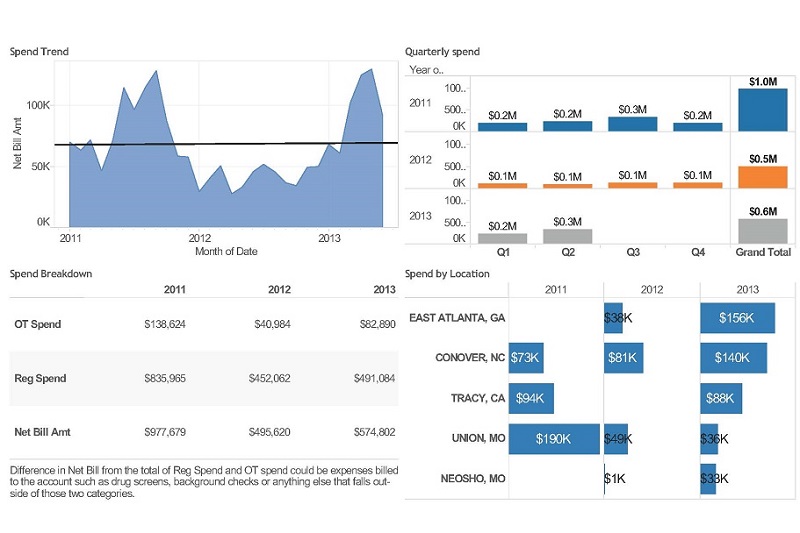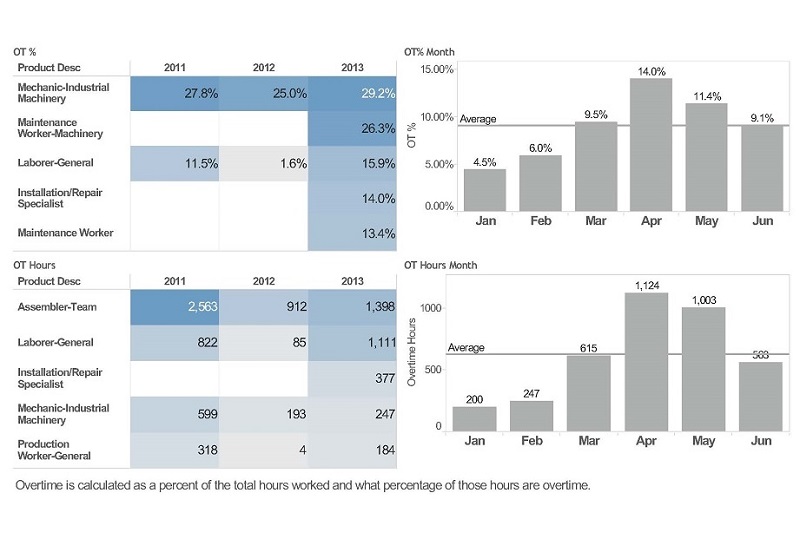ManpowerGroup Analytics: Now faster, better, and more strategic
With 400,000 clients in 80 countries and territories, ManpowerGroup had stores of data that it wanted to use to better serve its clients. But business users were accustomed to developing ad hoc reports and running on anecdotal insight rather than data. Using Tableau, ManpowerGroup has standardized its analytic efforts, increased the speed and quality of business review documents, and enabled truly strategic conversations.
Anecdotes, Queues, and Band-Aids
As one of the largest HR companies in the world, ManpowerGroup realized that it held a great deal of valuable data. But it needed to do a better job of using that information to drive competitive advantages for itself or its clients.
“Before, a lot of our information was very anecdotal,” says Anuwat Raviwongse, Director of Analytics for ManpowerGroup. “We kind of knew what was happening.”
ManpowerGroup needed to develop data-driven business review documents that could be used to drive strategic conversations. “The context for the documents is different for each client,” says Raviwongse.
Users asking the IT team to script and run reports from the Cognos Enterprise business intelligence solution faced a long queue. And if the resulting document answered the wrong question—or users developed new questions after seeing the results?
“They would have to go back to IT and request another report and wait, look at it, and go back to IT for another report and then wait again,” says Sarah Nell, Global Corporate Account Analyst at ManpowerGroup.
“Updating these reports took a lot of time,” adds Nell. “You couldn’t just have them automatically update.” Some teams tried to avoid the IT queue by creating their own business review documents from varying sources. “We had a lot of one-off solutions that worked for that Band-Aid moment,” Nell says.
This approach produced its own issues—the answers to a question could change depending upon who you asked. And these homegrown solutions carried the risk of errors.
“We had people using data incorrectly and they were creating different spreadsheet solutions surrounding that data and then providing that in reporting format,” says Nell.
Cutting and Pasting: For Art Class, Not Analytics
ManpowerGroup has offices in more than 80 locations across the globe. While North American data is housed in a data warehouse, data from other locations could be provided in a number of different formats.
“Each of our global areas has its own business intelligence repositories, whether Excel or Access or something else,” says Raviwongse. “If we want to get insight into a global client, we would go to our data warehouse for North American data and then try to blend that with whatever received from our other locations,” says Raviwongse.
In addition, some presentations required the team to blend data from external sources such as the Bureau of Labor Statistics or the Federal Reserve to provide a holistic view of a particular industry.
Blending information from these sorts of disparate data sources into a cohesive customer presentation was a long, manual process.
“It was a lot of cutting and pasting,” says Raviwongse. “A lot of Excel work and a lot of Access work.”
Raviwongse estimates that a single business review report for a large client would take a team of five people approximately three weeks to produce.
“Oh, Wow—We Like You”
In 2010, two events occurred that would change how ManpowerGroup viewed and used data: the company established an analytics team, and it acquired TAPFIN, a human resources managed services provider.
The newly-established corporate analytics team wanted to align its efforts with TAPFIN’s analytics—which was produced and distributed through Tableau Server.
A few, scattered people within ManpowerGroup were already using Tableau Desktop for client insight; the TAPFIN acquisition brought additional attention to Tableau, and usage began to mushroom.
“We wanted more flexibility in terms of the graphs and visualizations that we use. We wanted to be able to be independent from IT. And we wanted to be able to do the analysis and drill-through and have hierarchies pre-set based on the data,” says Raviwongse. “Tableau met those needs, which was a big contributor to why we started to expand (our use).”
“We only have about six people in the analytics group, but we support all of Manpower,” says Nell. “Demand is really high. We really needed a solution that would the needs for faster deliverables, ad hoc report requests—and we needed to make it sustainable.”
The analytics team began to provide Tableau visualizations for use in business reviews with clients. “That's when Tableau started picking up a lot of popularity,” says Nell.
“The teams saw our speed and thought, ‘Oh wow—we like you. Let's use you more.’ The visuals and the different drill-downs that we could provide—it was just leaps and bounds above what they were getting before,” she says.
Today, more than 20 people are authoring reports in Tableau and up to hundred are seeing and interacting with completed visualizations. The team is primarily self-taught, through videos from tableausoftware.com and power users training newer users. ManpowerGroup recently participated in its first Tableau Training on-site.
The analytics team usually works with data extracts for increased speed and performance, but occasionally will connect to larger data sources.
“I just recently connected to a data source with all of our client data in it, and I’d estimate that has more than 100 million rows,” says Nell.
TAPFIN continues publish its own analysis through Tableau Server, while the ManpowerGroup analytics group has been using Tableau Desktop. The team has just started experimenting with the hosted version of Tableau Server, Tableau Cloud.
“We want to be able to provide access to visualizations to people’s mobile devices, and we want to unplug from having to manage the infrastructure,” says Raviwongse of the choice to move to Tableau Cloud.
Better Blending, Fewer Band-Aids
“Today we can take five or six different reports and blend them into a single business review document. And if they don’t blend the way we need them to, we can just connect to another data source through Tableau,” says Nell. “It’s seamless in the presentation and the connection time is much less than it was previously.”

“We’re easily pulling in data from external sources and putting it into client-facing visualizations,” says Raviwongse.
And while the global offices of ManpowerGroup are not yet sharing data the way Raviwongse envisions, he is able to use Tableau to work with what he can get. “We can just call different branches around the world and have them send data and we stitch it together using Tableau.” This is far easier and faster than the previous process.
The analytics team has made great strides in eliminating ad hoc reporting and standardizing within the company.
“We took all of these different client reports that were utilized by different teams and brought them into analytics so we could create the solution through Tableau,” says Nell.
Now teams turn to the analytics department for their reporting needs, and they receive consistent answers based on standardized and validated data.
Internal adoption of the Tableau reports is higher than for previous reporting, a change Raviwongse attributes to the ease and value the Tableau reports offer.
Nell agrees, saying “Other departments see what we can do with Tableau and they think, ‘Oh, how can this impact what we're doing as well?’ Those one-off solutions, those Band-Aids, they don’t exist nearly as frequently anymore.”
Five people and three weeks for one client was yesterday’s reality. Now with Tableau, it is two people, fifty clients, in a day or two.
50x the Reports, Weeks Faster
Even with this increased demand, the analytics department is delivering better insight, faster than before.
“Five people and three weeks for one client was yesterday’s reality. Now with Tableau, it is two people, fifty clients, in a day or two,” says Raviwongse.
Nell appreciates that Tableau enables her to automatically update visualizations by simply refreshing her connections at the data source. No re-work is required as long as the data formatting remains the same.
“If I needed to update business review documents with Excel just two years ago, the time it would have taken me to do something like that is just astronomically different today,” says Nell. “It’s a complete night and day change.”
“Now with Tableau, if we receive a request for a client review, I could have it to them before the end of business,” says Nell. “We can respond with a level of immediacy and urgency that was not possible previously.”

Nell points out that it isn’t just the analytics team’s opinion that quality has improved. “I had a conversation with one of our client teams last week and they were just astounded at what we're able to provide them now,” she says. “We're providing greater insight into what is going on behind the scenes. So the client teams are getting better quality for even less effort than what we did before.”
“We’re Having Strategic Conversations Instead of Story Time”
Anecdotal or instinct-based decision-making is no longer the norm. “Now we're actually seeing what is driving a client right now,” says Nell.
“These conversations have evolved over the last few years due to how we're using Tableau—they never would have existed before. We're having strategic conversations now instead of story time.”
This access to timely, accurate information has increased accountability among customer teams. “Data—or lack of it—is no longer an excuse,” says Raviwongse. “We have the data. And we can crunch it quickly, look at it and move on.”
“Customer teams are more cognizant of how the program is running overall,” says Nell. “They're trying to be more efficient in how they manage placement and how people are going into their assignments.”
For example, client teams have started requesting Tableau analysis of placement turnover to get a better sense of the reason behind assignments that end. Teams can see visualizations of the various entry codes for assignment closure by specific time period, geography, and other data dimensions.

“This enables us to get ahead of the talent needs of our clients,” Raviwongse says, a change which has led to distinct benefits for ManpowerGroup as an organization.
“We've become a lot less transactional. Today we are lot more strategic for our key customers,” says Raviwongse. “We are more of a partner to our clients around the workforce and not just having ‘I need a temp tomorrow’ kind of conversations.”
For example, ManpowerGroup has worked with a consumer products company for 20 years. Over that time, the conversations were typically about the speed and quantity of ManpowerGroup’s temporary worker placement.
“Using Tableau, we were able to talk about how efficient it would be to blend multiple production lines and multiple warehouses—a sort of workforce leveling plan across factories,” says Raviwongse. “This could help this key customer obtain close to $100,000 in cost savings. We were able to uncover this because with Tableau we could regularly see and understand the different demand levels across different factories.”
New Opportunities
The ManpowerGroup analytics team has begun piloting analytics as a service.
“We are using Tableau as a platform to offer internal analysis to a hospital client, for example. They are in the Access-Excel world and were struggling with how to blend the data,” says Raviwongse.
“I said, ‘Hey, we can use Tableau to blend some of that data, visualize it, and match it up to what we have in our internal databases to give you a sense of how far off or on you are and how difficult it is to hire certain roles, and so on.”
ManpowerGroup is also testing Tableau for forecasting its own performance. The team has started to compare its regular IBM SPSS forecasting results with forecasts using the same measures within Tableau.
“We have found that there is some variation, but it’s very close,” says Nell. “So we feel that it is viable and that we can work with it. Now we just need to build it out and make it more robust.”
In the future, the team is thinking about embedding visualizations into the company-wide SharePoint site. ManpowerGroup has recently begun using salesforce.com company-wide, so that analytics team also has begun experimenting with the salesforce.com direct connector that became available in Tableau 8.